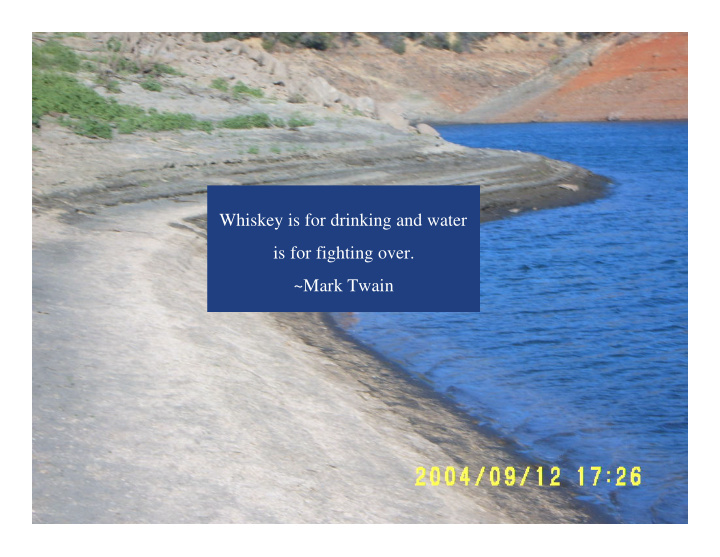



Whiskey is for drinking and water is for fighting over. ~Mark Twain
Preparing a Drought Management Management Plan
Steps in Preparing your Management Plan Steps in Preparing your Management Plan Obtain public input and involvement 1. Define goals and objectives 2. Assess water supply and demand conditions 3. Define drought indicators 4. Identify drought mitigation measures 5. Assess mitigation measures 6. Develop a drought index and management 7. strategy
1. Public Input and Involvement � Need public “buy-in” for plan to be successful � Create a Task Force or Committee Citizens � � Major Water Users Other Water Agencies � Businesses � � Civic Groups � Include Public Agencies Law Enforcement, Fire Dept., Parks Dept. �
2. Define Mitigation Goals and Objectives � Water-Use Priorities � Which water-users can and should be restricted Across-the-board or targeted restrictions � � What legal requirements need to be met � Minimum Flow Requirements � Reservoir Conservation Requirements � Do some water-users take priority over others � Fire Departments � Hospitals
3. Assess Supply and Demand � Identify Water � Determine Community Water Demand Supply Sources � Average and peak Who ultimately � demand controls the sources Historic demand trends � � Treatment � Use by customer sector infrastructure Interior vs. Exterior use � � Projected future demand � Determine the � Environmental demands Maximum Yield of Current Sources
Assess Supply and Demand (cont’d) � Identify Local � Compare water Conditions demand with supply yield State Water Law � � Current � Forecast potential Conservation Efforts deficits � Third-party effects of your groundwater
4. Define Drought Indicators � Palmer Index Based on soil moisture supply and demand � � Long Term � Reservoir Storage Reflects precipitation, surface runoff, and � groundwater � Groundwater Levels See “Introduction to Well Drawdown” on resource � CD for information on gauging your groundwater levels
5. Identify Mitigation Measures Pricing � � Public Information and � Excessive-use surcharges Education Drought surcharges � � Bill Stuffers/Fliers � Rationing (limit available Advertisements � supply) � Press Conferences � Local � Restrictions/Bans on Regulations/Ordinances Nonessential Use � Excess-use penalties � Ornamental Use Criminal Penalties for � (fountains, ponds) Noncompliance (fines) � Pavement/Street/Car Interagency cooperation � Washing
6. Assess Mitigation Measures � Anticipated water-use reduction � Consumer acceptance � Equity � Cost � Sustainability � Legal / Contractual Issues � History � Ease of Implementation
7. Develop your Plan � Adapt Drought Index and Management Strategy Template to suit your needs � Template samples based on California long-term drought commencing in 1986
Implementing a Drought Management Plan Implementing a Drought Management Plan
Steps in Implementing the Management Plan Steps in Implementing the Management Plan Formally adopt the Plan 1. Public Information and Education 2. Enforcing Drought Restrictions 3.
1. Formally Adopt the Plan � Approval of Citizen / Community Task Force � Approval of Local Officials � Approval of your Board of Directors
2. Public Information and Education � Pick ONE person to deal with the Media KEEP THE MEDIA INFORMED � � Let water-users know where to ask questions � Staff Booths at Local Events � Take advantage of large group gatherings � Bill Stuffers and Fliers � Drought Fact-Sheet � Demonstrate conservation equipment � Provide Updates
3. Enforcing Drought Restrictions � City / County / State Ordinances � Ask for local conservation ordinances to be instated � Incentive Programs � Supply retrofit devices � Conservation kits Provide rebates for water-saving appliances � � Disincentive Programs � Excess-use charges
Enforcing Drought Restrictions (cont’d) � Monitoring � Reactive � Respond to complaints made by other consumers � Least costly � Proactive � Actively patrol and issue warnings/conservation kits � Expensive � Possible “bad-cop” image
Enforcing Drought Restrictions (cont’d) � Noncompliance Penalties � First Offense � Issue a Warning � Supply with educational and retrofit materials � Second Offense � Minimal fine imposed on user’s bill � Third Offense � Steeper fine imposed on user’s bill � Consider cutting user’s water or installing a meter at their location
Recommend
More recommend